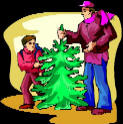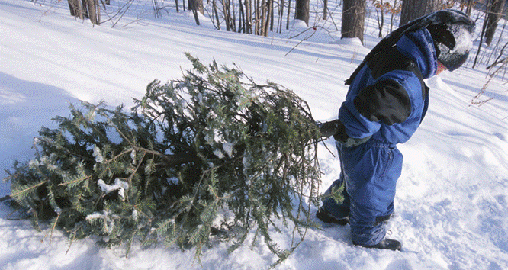
After Christmas, click here to find how how and where to easily recycle or dispose of your Christmas tree! And to recycle used, broken or old Christmas lights and electronics See this page for local options to easily recycle your Christmas holiday lights
Help me keep this page complete and up to date, by reporting any corrections needed or suggesting farms to add!
If it has just snowed; see this page about how to make snocones from real snow! Your kids will love it!
Tips:
- If the name of the farm is blue with an underline; that's a link to their website or Facebook page. Click on it for the most current hours and information.
- ALWAYS email or call the farm or store BEFORE YOU GO
- many farms have closed in the past year, and of course, we won't know until the season starts and we find they aren't open! Call to confirm their supply, their hours
and whether they have trees, are allowing choose-and-cut or just precut trees; and which attractions or winter activities are available.
All three can change during the short Christmas season, due to weather, demand and the farmer's business conditions! Farms get sold, shut down or run out of trees, and they don't all update me every day, let alone every year. For
more tips to make your trip fun and successful, click here
!
DON'T DRIVE OUT THERE IF YOU CAN'T REACH THEM (by phone, email or find current information on their website or Facebook page! - And please tell the farmer you visit in Southwestern Montana that you found their farm here! I need the farmers to realize that you found them here so that they will keep their information up to date!
If you want to provide feedback about a farm or the website , please let me know! There are affiliate links on this page. Read our disclosure policy to learn more. After Christmas, click here to find how how and where to easily recycle or dispose of your Christmas tree!
Looking for more info?
Updates for June 2025
June 2025:
After Christmas, click here to find how how and where to easily recycle or dispose of your Christmas tree! And to recycle used, broken or old Christmas lights and electronics See this page for local options to easily recycle your Christmas holiday lights
In March, you'll want to take your children to a free Easter egg hunt - see our companion website to find a local Easter Egg hunt - (www.EasterEggHuntsAndEasterEvents.org) . It's the ONLY website that is updated every Easter for all Easter Egg hunts in the U.S.
Christmas tree farms, lots and activities, sorted by county
Click on Resources above, if you need a county map
Beaverhead County
Deer Lodge County
Gallatin County
- Rocky Creek Farms - Christmas trees-you choose and you cut, hayrides, refreshments
Frontage Road E, Bozeman, MT 59715. Phone: 406-599-2361. Email: [email protected]. Open: Approximately Monday to Saturday from 10 am to 5 pm Raspberries - July Cucumbers, Corn - August, September Pumpkins - October. Directions: Go E from Bozeman on the Frontage Road approx. 5 miles, on your left you will see the sign. Cross over the railroad tracks, park at the little house. Our U-Cut Christmas tree operation features five tree species we grow for cutting as well as six additional species grown in milder areas. We offer a campfire, hayrides, and refreshments. And for a map to our farm, Click here. (UPDATED: December 9, 2024, JBS)
Granite County
Madison County
Park County
Ravalli County
-
Bitterroot Evergreens - Wreaths and swaps
(No Christmas trees for sale)
478 Tushapaw Road Victor, MT 59875. Phone: 866-642-3618. Email: [email protected] Open: from mid- November, 7 days a week until mid-December. Our wreaths are handcrafted of freshly harvested fir boughs attractively accented with pine cones, juniper, red berries, and a beautiful red velvet bow. Approximately 22" in diameter, sealed in plastic to preserve that uniquely fresh Montana fragrance.
Includes your own personalized holiday message! Shipped anywhere in the U.S.A..
Silver Bow County

Cut Your Own Tree in a National Forest in Montana
- Cut your own tree from a Montana National Forest (with a permit!):
Christmas tree permits become available usually in November. Trees cut
with these permits must be less than the specified height for each
forest (see below). Permits may be
available through some commercial outlets. Information regarding other
applicable regulations are available at any district office.
(Guide to Christmas Tree Cutting)
The permits are typically $15 (valid
for up to 3 trees),
There is now a centralized place online to buy a Christmas tree permit in a national forest in any state that has a forest that allows it; see this page on Recreation.gov.

Key Points to remember about cutting a Christmas tree in a National Forest
Permits:
Though you can purchase a permit online beginning mid-November, cutting is not allowed until mid-November and ends Dec. 31.
Up to three Christmas tree permits are allowed per family.
Display your permit on the dashboard of your vehicle when harvesting the tree(s). You must carry the permit with you and attach it to the tree during transportation.
Permits are good for all National Forests in Montana
Where to Cut Your Tree
You can cut anywhere on Forest Service or BLM lands, except you may not cut trees from plantations, Wilderness Areas, Recreation Areas, or within developed recreation areas, campgrounds,
Cutting details
Do not cut the tops off trees and do not cut down trees taller than 12 feet.
Cut the tree close to the ground: The stump you leave must be less than 6 five inches tall
Do not cut trees visible from major roads, within 150-feet of streams and creeks, or in other well-used areas.
Bring you own saws and equipment you'll need to cut the tree,
You may want to bring a sled to carry the tree to your vehicle, and of course, rope, netting, tarp, etc to tie down the tree to your car or truck.
Do not cut on private land, in wilderness areas, designated campgrounds, or existing tree plantations.
Do not cut in active timber sales or areas that have been planted with new trees.
Each forest has limitations on the size of the tree you can cut and the species of trees that are permitted.
Select a tree with a trunk six inches or less in diameter, and cut the tree no more than six inches above ground level.
Take the whole tree. Do not remove the top of the tree; cut down the entire tree
If snow is on the ground, remove it from around the stump so you can accurately measure the stump and tree height.
Southwest Montana
-
Beaverhead-Deerlodge National Forest -
Christmas trees-you choose and you cut,
Dillon, MT. This is the largest national forest in Montana and spans 8 counties close to Butte. Click here to get your Beaverhead-Deerlodge National Forest Christmas Tree Permit. -
Bitterroot National Forest -
Christmas trees-you choose and you cut,
Hamilton, MT. Located in southwest Montana. Click here to get your Bitterroot National Forest Christmas Tree Permit. Christmas tree permit may also be purchased for at any Forest Service office or at authorized retailers including Bob Ward's in Hamilton, Mr. T's in Darby, Merc Fresh Market in Corvallis, Cenex in Stevensville, and the Lone Pine Conoco in Hamilton. -
Custer-Gallatin National Forest
- Christmas trees-you choose and you cut,
Bozeman, MT. Located in the south, from the Yellowstone National Park entrance in southwest Montana stretching east to South Dakota, Their main office is in Bozeman and they have other offices and ranger stations but these days you can get the permits online, so that's rather immaterial! Click here to get your Custer Gallatin National Forest Christmas Tree Permit. Permits for the 2021 Holiday season are free again, (usually a $5.00/tree per permit, limit 3). A small transaction fee is associated with the online platform. Fourth graders, through Every Kid Outdoors, can also obtain a free permit through Recreation.gov.
For Easter egg Hunts, Children's Consignment Sales, Local Farm Markets and other types of Farms, click here.
Find Other types of farms:
- Farm markets and roadside stands
- Road trips and camping resources
- Home canning supplies at the best prices on the internet!
- Maple Syrup Farms, sugarworks, maple syrup festivals
- Environmental information and resources
- Consumer fraud and scams information
- Farms For Your Event for birthday parties, weddings, receptions, business meetings, retreats, etc.
- Pick Your Own fruits and vegetable farms
- Festivals - local fruit and vegetable festivals
- Local Honey, apiaries, beekeepers
- Local Meat, Milk and Eggs
Get the
most recent version of
the Ball Blue Book
Find Other types of farms:
- Farm markets and roadside stands
- Road trips and camping resources
- Home canning supplies at the best prices on the internet!
- Maple Syrup Farms, sugarworks, maple syrup festivals
- Environmental information and resources
- Consumer fraud and scams information
- Farms For Your Event for birthday parties, weddings, receptions, business meetings, retreats, etc.
- Pick Your Own fruits and vegetable farms
- Festivals - local fruit and vegetable festivals
- Local Honey, apiaries, beekeepers
- Local Meat, Milk and Eggs
Get the
most recent version of
the Ball Blue Book